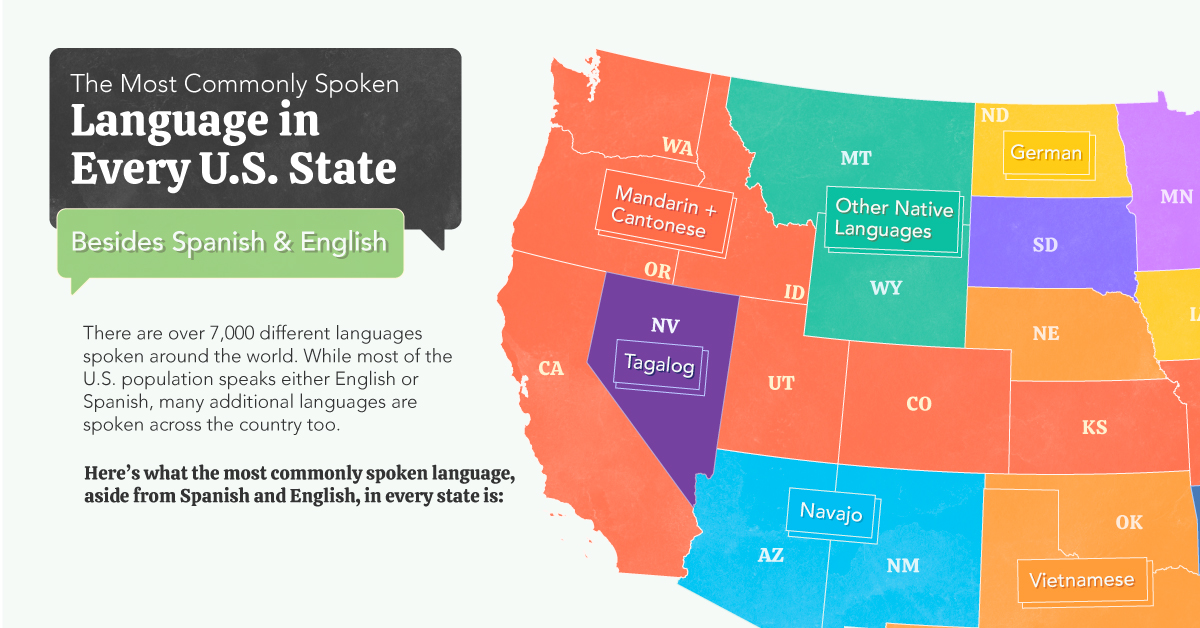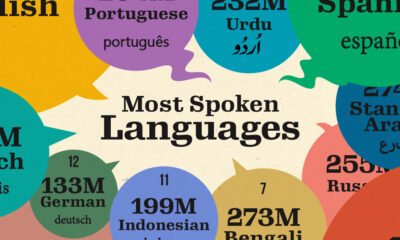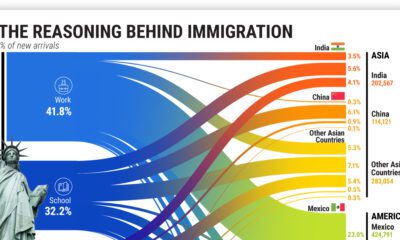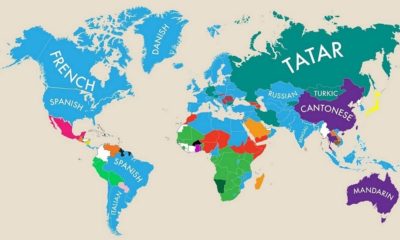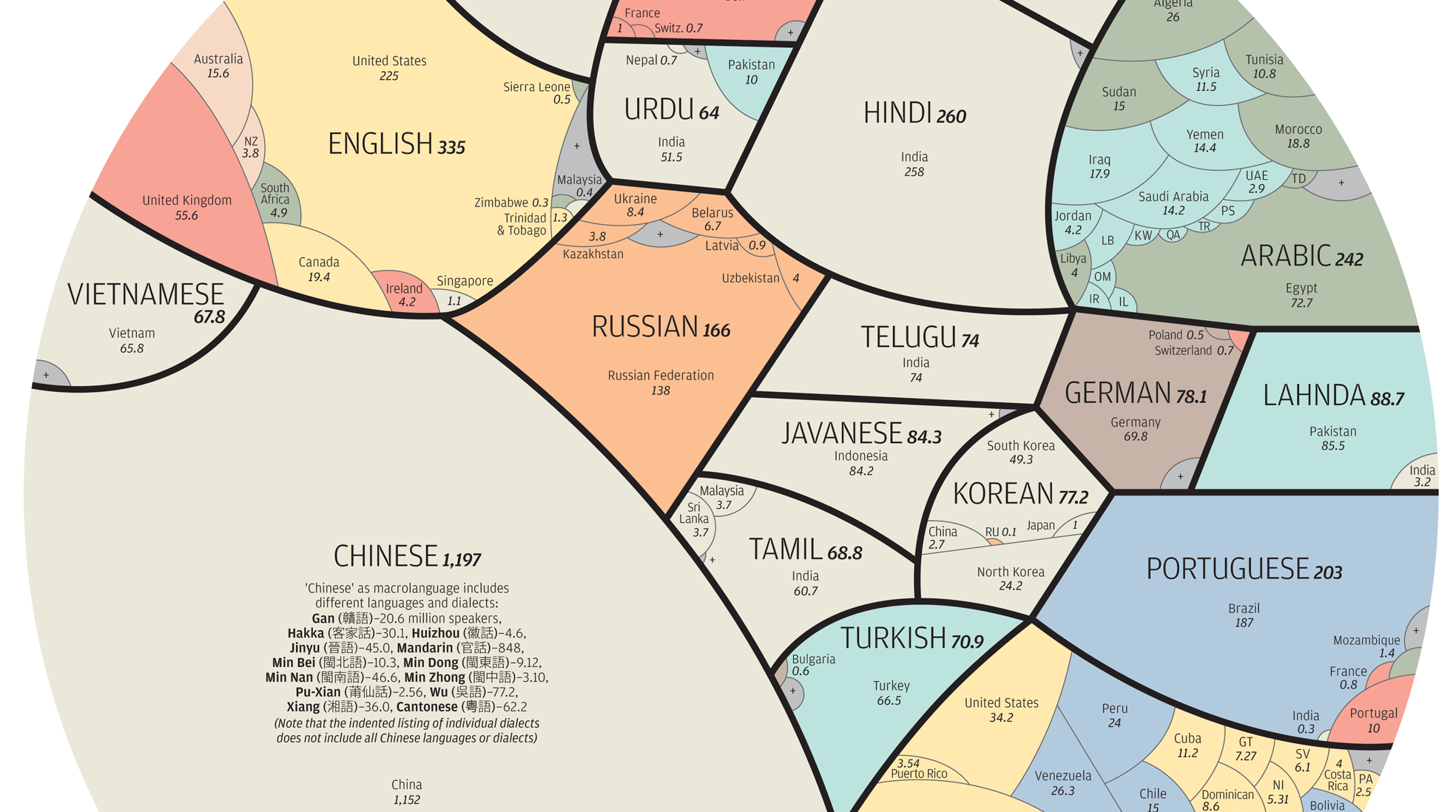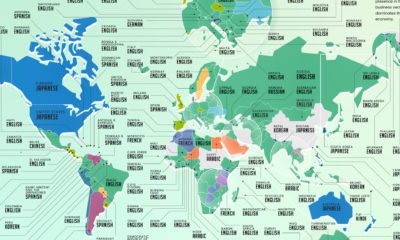Misc
The Most Commonly Spoken Language in Every U.S. State (Besides English and Spanish)
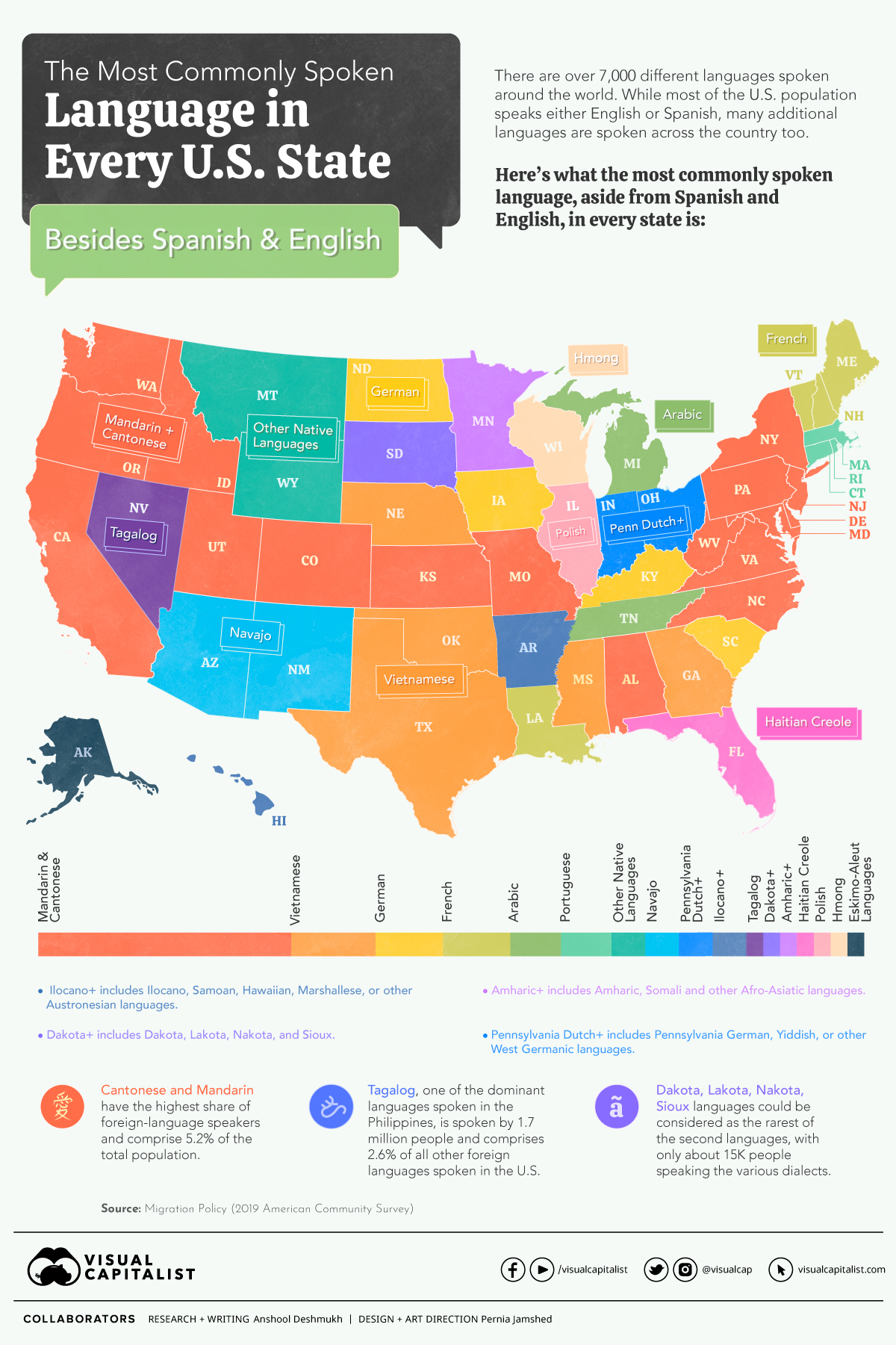
The Most Common Spoken Household Languages
We typically operate under the assumption that most Americans speak either English or Spanish. Though this is true in the broadest sense, the U.S. is a culturally diverse country, home to a plethora of languages.
The U.S. Census Bureau’s American Community Survey (ACS) annually asks more than 1 million Americans questions about their lives, families, and backgrounds. One question asks respondents what language they mainly speak in their homes.
Migration Policy has used this data (while excluding English and Spanish) to leave us with the next-most-frequently spoken languages at home in each state.
Non-English Languages in the U.S.
In 2019, approximately 78% (241 million) of all 308.8 million people ages five and older reported speaking only English at home regardless of their nativity. The remaining 22% (67.8 million) reported speaking a language other than English at home.
Based on this data, Mandarin and Cantonese were the most common non-English, non-Spanish languages spoken in the U.S., with more than 3.4 million speakers across the country.
Here is a list of the most common languages spoken at home in the U.S., outside of English:
| Language | Population Estimate | Share of Foreign Language Speakers |
|---|---|---|
| Spanish | 41,757,000 | 61.6% |
| Cantonese and Mandarin | 3,495,000 | 5.2% |
| Tagalog | 1,764,000 | 2.6% |
| Vietnamese | 1,571,000 | 2.3% |
| Arabic | 1,260,000 | 1.9% |
| French and Louisiana French | 1,172,000 | 1.7% |
| Korean | 1,075,000 | 1.6% |
| Russian | 941,000 | 1.4% |
| Haitian Creole | 925,000 | 1.4% |
| German | 895,000 | 1.3% |
| Hindi | 893,000 | 1.3% |
| Portuguese | 846,000 | 1.2% |
| Afro-Asiatic Languages | 590,000 | 0.9% |
| West African Languages | 589,000 | 0.9% |
| Indo-European Languages | 576,000 | 0.8% |
| West Germanic Languages | 560,000 | 0.8% |
| Italian | 540,000 | 0.8% |
Tagalog is the second most commonly spoken language in American households (after English/Spanish) with 1.7 million speakers, even though it only reaches top spot in Nevada. Unsurprisingly, Louisiana and states bordering eastern Canada have a healthy number of French speakers.
Further analysis of these common languages reveals a fascinating story. Here’s a breakdown of the top 5 most commonly spoken second languages (excluding English and Spanish), and the states where they’re spoken.
1. Cantonese and Mandarin
Estimated number of speakers nationally: 3,495,000
Number of states where it’s the most common: 17
States that most commonly speak the language: California, Washington, Oregon, Idaho, Utah, Colorado, Kansas, Missouri, Alabama, New York, Pennsylvania, Virginia, West Virginia, North Carolina, New Jersey, Delaware and Maryland.
Chinese immigrants have been coming to America in large numbers since the mid-19th century, when the California Gold Rush compelled them to cross the Pacific Ocean. Today, there are over 5 million Chinese Americans across the country.
2. Tagalog
Estimated number of speakers nationally: 1,764,000
Number of states where it’s the most common: 1
States that most commonly speak the language: Nevada
Immigrants from the Philippines started coming to America in large numbers by the turn of the 19th century, but it wasn’t until 1965 that both skilled and educated workers came by the thousands. Today, there are over 4 million Filipino Americans.
3. Vietnamese
Estimated number of speakers nationally: 1,571,000
Number of states where it’s the most common: 5
States that most commonly speak the language: Nebraska, Oklahoma, Texas, Mississippi and Georgia.
South Vietnamese immigration to the U.S. began right after the Vietnam War ended in 1975, and more Vietnamese people have been arriving ever since. Today, over half of all Vietnamese-Americans live in either California or Texas.
4. Arabic
Estimated number of speakers nationally: 1,260,000
Number of states where it’s the most common: 2
States that most commonly speak the language: Michigan and Tennessee
Michigan alone has over 140,000 Arabic speakers. California has over 190,000 speakers. Pew Research Center noted that Arabic is the fastest-growing language in the U.S., with speakers growing by 29% from 2010 to 2014.
5. French
Estimated number of speakers nationally: 1,172,000
Number of states where it’s the most common: 4
States that most commonly speak the language: Louisiana, Maine, Vermont and New Hampshire.
After the Louisiana Purchase, French evolved from its original form, creating Louisiana French which also borrows words from English, Spanish, Native American, and African languages. To this day, it’s still spoken by around 175,000 people in Louisiana and Texas.
The United States: A Multilingual Country
Although English, in all its diversity, is unquestionably the country’s dominant national language, the U.S. has always had a complex multilingual history. Long before European settlers colonized North and South America, thousands of indigenous languages thrived from coast to coast. Today, some Indigenous languages are making a comeback as many states acknowledge their importance in the history and culture of the country.
With each new wave of immigrants residing in the country from every part of the globe, the linguistic and cultural diversity of the United States is growing.
The U.S. has one of the largest Chinese populations outside China, a demographic shift that may increase in the coming years. Spanish is now the most popular second language of the country.
America is home to the largest population of English speakers in the world, but bilingualism has been on the rise in the country for decades – a trend that shows no signs of letting up.
VC+
VC+: Get Our Key Takeaways From the IMF’s World Economic Outlook
A sneak preview of the exclusive VC+ Special Dispatch—your shortcut to understanding IMF’s World Economic Outlook report.

Have you read IMF’s latest World Economic Outlook yet? At a daunting 202 pages, we don’t blame you if it’s still on your to-do list.
But don’t worry, you don’t need to read the whole April release, because we’ve already done the hard work for you.
To save you time and effort, the Visual Capitalist team has compiled a visual analysis of everything you need to know from the report—and our VC+ Special Dispatch is available exclusively to VC+ members. All you need to do is log into the VC+ Archive.
If you’re not already subscribed to VC+, make sure you sign up now to access the full analysis of the IMF report, and more (we release similar deep dives every week).
For now, here’s what VC+ members get to see.
Your Shortcut to Understanding IMF’s World Economic Outlook
With long and short-term growth prospects declining for many countries around the world, this Special Dispatch offers a visual analysis of the key figures and takeaways from the IMF’s report including:
- The global decline in economic growth forecasts
- Real GDP growth and inflation forecasts for major nations in 2024
- When interest rate cuts will happen and interest rate forecasts
- How debt-to-GDP ratios have changed since 2000
- And much more!
Get the Full Breakdown in the Next VC+ Special Dispatch
VC+ members can access the full Special Dispatch by logging into the VC+ Archive, where you can also check out previous releases.
Make sure you join VC+ now to see exclusive charts and the full analysis of key takeaways from IMF’s World Economic Outlook.
Don’t miss out. Become a VC+ member today.
What You Get When You Become a VC+ Member
VC+ is Visual Capitalist’s premium subscription. As a member, you’ll get the following:
- Special Dispatches: Deep dive visual briefings on crucial reports and global trends
- Markets This Month: A snappy summary of the state of the markets and what to look out for
- The Trendline: Weekly curation of the best visualizations from across the globe
- Global Forecast Series: Our flagship annual report that covers everything you need to know related to the economy, markets, geopolitics, and the latest tech trends
- VC+ Archive: Hundreds of previously released VC+ briefings and reports that you’ve been missing out on, all in one dedicated hub
You can get all of the above, and more, by joining VC+ today.
-

 Education1 week ago
Education1 week agoHow Hard Is It to Get Into an Ivy League School?
-

 Technology2 weeks ago
Technology2 weeks agoRanked: Semiconductor Companies by Industry Revenue Share
-

 Markets2 weeks ago
Markets2 weeks agoRanked: The World’s Top Flight Routes, by Revenue
-

 Demographics2 weeks ago
Demographics2 weeks agoPopulation Projections: The World’s 6 Largest Countries in 2075
-

 Markets2 weeks ago
Markets2 weeks agoThe Top 10 States by Real GDP Growth in 2023
-

 Demographics2 weeks ago
Demographics2 weeks agoThe Smallest Gender Wage Gaps in OECD Countries
-

 Economy2 weeks ago
Economy2 weeks agoWhere U.S. Inflation Hit the Hardest in March 2024
-

 Green2 weeks ago
Green2 weeks agoTop Countries By Forest Growth Since 2001



